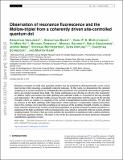Observation of resonance fluorescence and the Mollow triplet from a coherently driven site-controlled quantum dot
Abstract
Resonant excitation of solid state quantum emitters has the potential to deterministically excite a localized exciton while ensuring maximally coherent emission. In this work, we demonstrate the coherent coupling of an exciton localized in a lithographically positioned, site-controlled semiconductor quantum dot to an external resonant laser field. For strong continuous-wave driving we observe the characteristic Mollow triplet and analyze the Rabi splitting and sideband widths as a function of driving strength and temperature. The sideband widths increase linearly with temperature and the square of the driving strength, which we explain via coupling of the exciton to longitudinal acoustic phonons. We also find an increase of the Rabi splitting with temperature, which indicates a temperature-induced delocalization of the excitonic wave function resulting in an increase of the oscillator strength. Finally, we demonstrate coherent control of the exciton excited state population via pulsed resonant excitation and observe a damping of the Rabi oscillations with increasing pulse area, which is consistent with our excitonx2013;photon coupling model. We believe that our work outlines the possibility to implement fully scalable platforms of solid state quantum emitters. Such scalability is one of the key prerequisites for more advanced, integrated nanophotonic quantum circuits.
Citation
Unsleber , S , Maier , S , McCutcheon , D P S , He , Y-M , Dambach , M , Gschrey , M , Gregersen , N , Mørk , J , Reitzenstein , S , Höfling , S , Schneider , C & Kamp , M 2015 , ' Observation of resonance fluorescence and the Mollow triplet from a coherently driven site-controlled quantum dot ' , Optica , vol. 2 , no. 12 , pp. 1072-1077 . https://doi.org/10.1364/OPTICA.2.001072
Publication
Optica
Status
Peer reviewed
ISSN
2334-2536Type
Journal article
Description
This work was funded by project SIQUTE (contract EXL02) of the European Metrology Research Programme (EMRP). The EMRP is jointly funded by the EMRP participating countries within EURAMET and the European Union. Support was provided from the Villum Foundation via the VKR Centre of Excellence NATEC.Collections
Items in the St Andrews Research Repository are protected by copyright, with all rights reserved, unless otherwise indicated.

